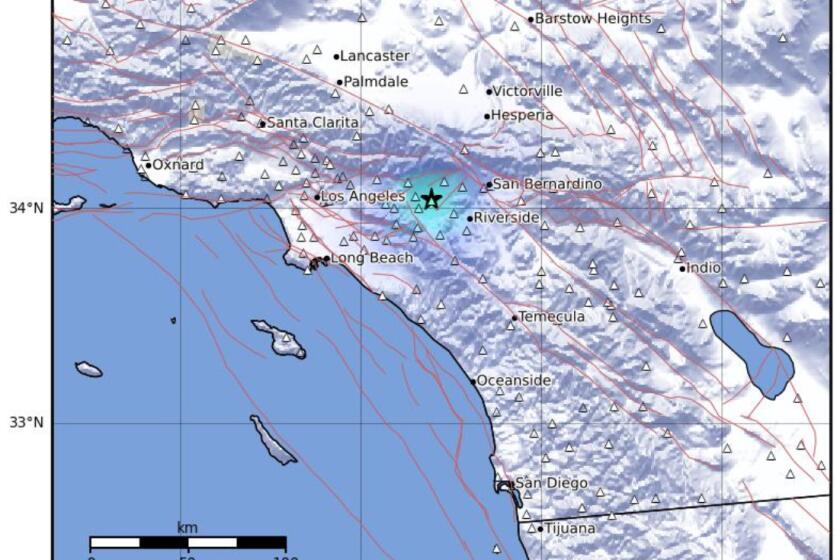5 Years After Loma Prieta’s Deadly Shudder, Signs of Recovery
APTOS, Calif. — As you walk along a narrow trail winding through a steep canyon shaded with redwoods, firs and oaks, it’s hard to believe the earth below once spawned a devastating earthquake.
But deep within the ground beneath your feet, a deadly shudder arose on Oct. 17, 1989. Its shock waves killed 63 people and injured more than 3,700, caused $5.9 billion in damage, broke freeways and bridges and destroyed or weakened tens of thousands of buildings.
Five years later, here at the epicenter of the Loma Prieta earthquake, the only traces of the destruction are a modest sign and a few fallen trees. But you don’t have to go far to find other reminders.
Empty lots gap like missing teeth on main streets in Watsonville, 15 miles to the southeast, and Santa Cruz, 15 miles west. In Oakland, 50 miles away, the Cypress section of Interstate 880, where 42 people died in a ruin of collapsing pavement, has yet to be rebuilt.
Oakland’s landmark City Hall is still closed, undergoing repairs expected to last another year, and many downtown businesses remain boarded up.
In San Francisco, 65 miles away, the devastated Marina District has recovered, but timbers still support cracked stone archways in City Hall, and damaged freeways have yet to be fixed or replaced.
“The long-term ramifications of Loma Prieta are being felt far beyond the events of October, 1989,” said Jim Drago, spokesman for Caltrans.
He and others blame delays on many different things: red tape, essential engineering research, the stubborn recession, public resistance to some projects and the sheer size of some repairs.
But they also believe the 15-second quake had at least one positive effect.
“It helped, I think, to focus our sight on the gallows,” said Alan Lindh, a seismologist at the U.S. Geological Survey in Menlo Park. “And there’s the saying that the sight of the gallows concentrates the mind.”
Northern California is better prepared for a major temblor now than it was five years ago, Lindh and disaster experts believe. The region, which had not had a truly disastrous quake since 1906, really didn’t know what to expect before Loma Prieta.
“Since 1989 there’s been an immediacy of preparedness. Up until ’89 we were talking about what might happen. ’89 showed us in fact what will happen,” said Richard Eisner, director of the state Office of Emergency Services’ earthquake preparedness program.
The quake taught different governments and agencies how to cooperate during disasters and plan for future ones, said Lowell Hurst, mayor of Watsonville.
San Francisco’s director of emergency services, retired Adm. John Bitoff, said cities like San Francisco and Oakland also have greatly improved emergency communications systems. “I’m not satisfied yet, but as I told the mayor the other day, ‘You don’t want me to be satisfied,’ ” he said.
Loma Prieta also helped ready the region for the Next One through a kind of “structural Darwinism,” Eisner said. “The earthquake in ’89 brought down the worst of the hazardous structures,” he said. Most were old, unreinforced masonry buildings.
Many surviving buildings that were damaged or considered at risk are being strengthened. New strengthening techniques are being used that were learned as a result of Loma Prieta, Eisner said.
After the quake, the state required local governments to set up emergency plans and let cities and counties impose stricter building standards than those required by Sacramento. The state also started a program to evaluate the safety of bridges and freeways and began strengthening them.
“The fact of the matter is that Loma Prieta started what is really the world’s most ambitious seismic retrofitting program, period,” said Drago, of Caltrans. The 6.8 quake in Los Angeles last January, which killed at least 58 people and did an estimated $20 billion in damage, only reinforced the commitment to make freeways quake resistant, he said.
Southern California freeways and bridges were quickly repaired because they were newer, simpler spans, he said. The ones in Northern California were older, multilevel constructions that required much research.
“They tell me that the advance of seismic and structural engineering since Loma Prieta would be the equivalent of when we made the advance from the horse to the auto,” Drago said.
The epicenter of Loma Prieta--named for a nearby peak in the Santa Cruz Mountains--is within the Forest of Nisene Marks State Park, near a trail that winds along a canyon creek.
The trail was seldom visited until scientists determined the epicenter’s location. During Christmas week, 1989, 5,000 people a day visited, said ranger Gerry Waggoner.
“A lot of people are disappointed to find there is only a sign there,” he said. “They expected to find a hole in the ground.” The crowds are gone, but the trail remains a popular hike, for its scenery as much as its geologic significance.
In a way, it’s a metaphor for California--sometimes perilous, but often spectacular. Scientists and disaster experts say quakes can be prepared for, and can be considered the price for the region’s beauty.
“Earthquakes are a manageable problem,” Lindh said. “You don’t like mountains and beautiful scenery? Move.”
More to Read
Sign up for Essential California
The most important California stories and recommendations in your inbox every morning.
You may occasionally receive promotional content from the Los Angeles Times.










